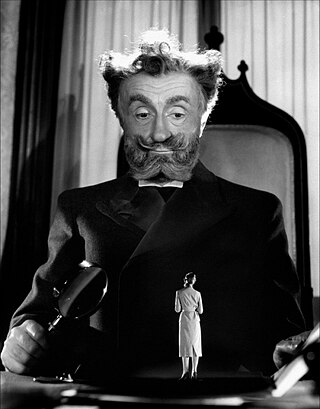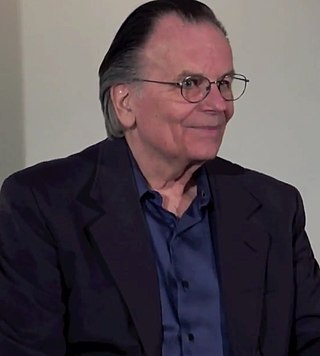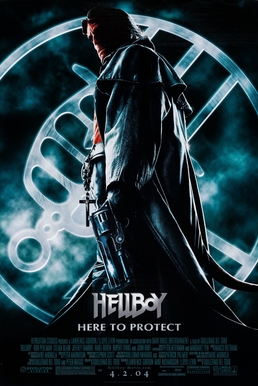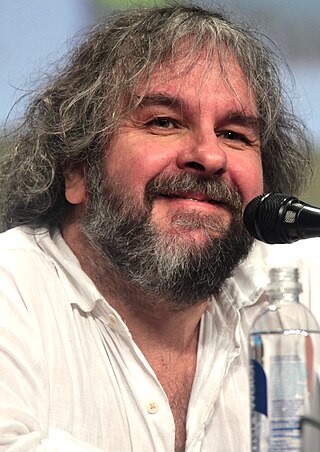
Special effects are illusions or visual tricks used in the theatre, film, television, video game, amusement park and simulator industries to simulate the imagined events in a story or virtual world. It is sometimes abbreviated as SFX, but this may also refer to sound effects.

Cinematography is the art of motion picture photography.
Among motion pictures of Middle-earth in various formats, The Lord of the Rings is a trilogy of epic fantasy adventure films directed by Peter Jackson, based on the novel The Lord of the Rings by British author J. R. R. Tolkien. The films are subtitled The Fellowship of the Ring (2001), The Two Towers (2002), and The Return of the King (2003). Produced and distributed by New Line Cinema with the co-production of WingNut Films, the films feature an ensemble cast including Elijah Wood, Ian McKellen, Liv Tyler, Viggo Mortensen, Sean Astin, Cate Blanchett, John Rhys-Davies, Christopher Lee, Billy Boyd, Dominic Monaghan, Orlando Bloom, Hugo Weaving, Andy Serkis, and Sean Bean.

The Frighteners is a 1996 supernatural comedy horror film directed by Peter Jackson and co-written with Fran Walsh. The film stars Michael J. Fox, Trini Alvarado, Peter Dobson, John Astin, Dee Wallace Stone, Jeffrey Combs, R. Lee Ermey and Jake Busey. The Frighteners tells the story of Frank Bannister (Fox), an architect who develops psychic abilities allowing him to see, hear, and communicate with ghosts after his wife's murder. He initially uses his new abilities to befriend ghosts, whom he sends to haunt people so that he can charge them handsome fees for "exorcising" the ghosts. However, the spirit of a mass murderer appears posing as the Grim Reaper, able to attack the living and the dead, prompting Frank to investigate the supernatural presence.

Producers Releasing Corporation was the smallest and least prestigious of the 11 Hollywood film companies of the 1940s. It was considered a prime example of what was called "Poverty Row": a low-rent stretch of Gower Street in Hollywood where shoestring film producers based their operations. However, PRC was more substantial than the usual independent companies that made only a few low-budget movies and then disappeared. PRC was an actual Hollywood studio – albeit the smallest – with its own production facilities and distribution network, and it even accepted imports from the UK. PRC lasted from 1939 to 1947, churning out low-budget B movies for the lower half of a double bill or the upper half of a neighborhood theater showing second-run films. The studio was originally located at 1440 N. Gower St. from 1936 to 1943. PRC then occupied the former Grand National Pictures physical plant at 7324 Santa Monica Blvd., from 1943 to 1947. This address is now an apartment complex.

Gary Douglas Kurtz was an American film producer whose list of credits includes American Graffiti (1973), Star Wars (1977), The Empire Strikes Back (1980), The Dark Crystal (1982) and Return to Oz (1985). Kurtz also co-produced the 1989 science fiction adventure film Slipstream, which reunited him with Star Wars star Mark Hamill.

Caravan Pictures, Inc. was an American film production company at Walt Disney Studios, formed by Roger Birnbaum and Joe Roth. Caravan Pictures' films were distributed by Buena Vista Pictures Distribution.
A production company, production house, production studio, or a production team is a studio that creates works in the fields of performing arts, new media art, film, television, radio, comics, interactive arts, video games, websites, music, and video. These groups consist of technical staff and members to produce the media, and are often incorporated as a commercial publisher.

Guillermo del Toro Gómez is a Mexican filmmaker. His work has been characterized by a strong connection to fairy tales and horror, with an effort to infuse visual or poetic beauty in the grotesque. He has had a lifelong fascination with monsters, which he considers symbols of great power. He is also known for his use of insectile and religious imagery, his themes of Catholicism, anti-fascism, and celebrating imperfection, underworld motifs, practical special effects, and dominant amber lighting.
Joseph Francis Biroc, ASC was an American cinematographer. He was born in New York City and began working in films at the Paragon Studios in Fort Lee, New Jersey. After working there for approximately six years, he moved to Los Angeles. Once in Southern California, Biroc worked at the RKO Pictures movie studio. During World War II, he served in the U.S. Army Signal Corps and filmed the Liberation of Paris in August 1944. In 1950, Biroc left RKO Pictures and freelanced on projects at various studios. In addition to his film work, which included It's a Wonderful Life (1946) and The Flight of the Phoenix (1965), Biroc worked on various television series, including the Adventures of Superman and Wonder Woman. He frequently collaborated with film director Robert Aldrich.
Edward Summer was an American painter, motion picture director, screenwriter, internet publisher, magazine editor, journalist and science writer, comic book writer, novelist, book designer, actor, cinematographer, motion picture editor, documentary filmmaker, film festival founder, and educator. He died on November 13, 2014.

Hellboy II: The Golden Army is a 2008 American superhero film based on the Dark Horse Comics character of the same name, created by Mike Mignola. Produced by Lawrence Gordon and Lloyd Levin in association with Dark Horse Entertainment, and distributed by Universal Pictures, it is a sequel to Hellboy (2004) and is the second live-action film in the franchise. Directed and written by Guillermo del Toro from a story he co-wrote with Mignola, the film stars Ron Perlman as Hellboy, alongside Selma Blair, Doug Jones, Jeffrey Tambor, and John Hurt. In the film, Hellboy and the Bureau of Paranormal Research and Defense must battle a mythical prince who plans to reclaim the world for his magical kindred.

Hellboy is a 2004 American superhero film based on the Dark Horse Comics character of the same name, created by Mike Mignola. Produced by Revolution Studios, Lawrence Gordon/Lloyd Levin Productions, and Dark Horse Entertainment, and distributed by Revolution and Sony Pictures Releasing's Columbia Pictures, it is the first live-action film in the Hellboy franchise. Directed and written by Guillermo del Toro, the film stars Ron Perlman in the title role, alongside Selma Blair, Jeffrey Tambor, Karel Roden, Rupert Evans, and John Hurt. The film draws inspiration from the debut comic Hellboy: Seed of Destruction. In the film, a charismatic demon-turned-investigator named "Hellboy" works with the secretive Bureau of Paranormal Research and Defense to suppress paranormal threats, when a resurrected sorcerer seeks to make Hellboy fulfill his destiny by triggering the apocalypse.
The production of The Lord of the Rings film series posed enormous challenges, both logistical and creative. Under Peter Jackson's direction, these obstacles were overcome between 1997 and 2004. Many attempts to produce J. R. R. Tolkien's fantasy novel The Lord of the Rings had failed; the few that had reached the screen were animations. Since the publication of the source novels in the mid-1950s, many filmmakers and producers had considered a film but then set the project aside. The series as filmed by Jackson consists of three epic fantasy adventure films. They were produced by New Line Cinema, assisted by WingNut Films. The cinema versions appeared between 2001 and 2003, and the extended edition for home video in 2004. Development began in August 1997. The films were shot simultaneously. Their production was undertaken entirely in Jackson's native New Zealand. It spanned the 14-month period from October 1999 until December 2000, with pick-up shots filmed over a further 24 months, from 2001 to 2003.

Sir Peter Robert Jackson is a New Zealand film director, screenwriter and producer. He is best known as the director, writer and producer of the Lord of the Rings trilogy (2001–2003) and the Hobbit trilogy (2012–2014), both of which are adapted from the novels of the same name by J. R. R. Tolkien. Other notable films include the critically lauded drama Heavenly Creatures (1994), the horror comedy The Frighteners (1996), the epic monster remake film King Kong (2005), the World War I documentary film They Shall Not Grow Old (2018) and the documentary The Beatles: Get Back (2021). He is the fourth-highest-grossing film director of all-time, his films having made over $6.5 billion worldwide.

A film —also called a movie, motion picture, moving picture, picture, photoplay, or flick—is a work of visual art that simulates experiences and otherwise communicates ideas, stories, perceptions, emotions, or atmosphere through the use of moving images that are generally accompanied by sound and other sensory stimulations. The word "cinema" is a shortening of the word "cinematography" and is used to refer to either filmmaking, the film industry, the overall art form, or a movie theater.
Pūkeko Pictures is a New Zealand based entertainment company. It produces a mix of live-action, animated, games and picture books for the global entertainment market.

The following is a list of unproduced Guillermo del Toro projects in roughly chronological order. During his decades-long career, Mexican filmmaker and author Guillermo del Toro has worked on a number of projects that never progressed beyond the pre-production stage. Some of these projects fell into development hell and are presumably canceled, while some were taken over and completed by other filmmakers.

John Arnold (1889–1964) was an American cinematographer. He began his career in 1914, and in the next 15 years, he shot 86 films. He also worked in film administration, directing the cinematography department at MGM, and was president of the American Society of Cinematographers from 1931 through 1937, and again from 1939 to 1941. By 1938, he was regarded as one of the most authoritative experts on cinematography. He invented several pieces of camera equipment and was awarded two Oscars, both Technical Achievement Awards. The first was in 1938 for improvements on the semi-automatic follow focus device used on motion picture cameras, while the second was in 1940 for the development of the MGM mobile camera crane.













